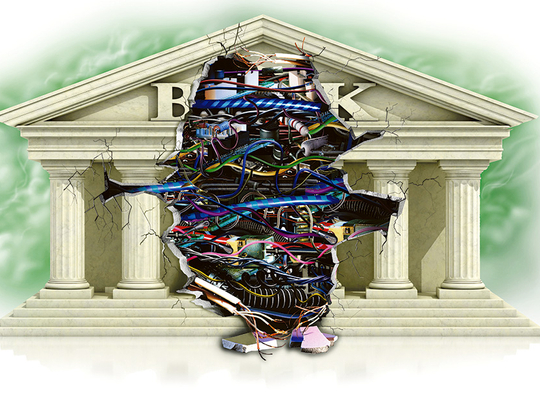
Despite what you may have heard, not every industry is destined to fall at the point of a start-up’s sword. Unlike taxi and hotel operators, banks are proving more formidable to disrupt. “Fintechs [start-ups employing tech to support or enable banking and financial services] are good with challenger models and being creative through out-of-the-box thinking, but they have no customers,” says David Horton, Head of Innovation at Synechron, a Dubai-based consulting and tech services company.
To fend off fintech competition and compete in the digital age, lenders are rolling out online and mobile services. However, banks need to do more than develop apps. Real digitisation requires extensive back-end rewiring. Behind most banks’ apps and digital platforms is archaic technology.
Chris Skinner, a digital banking expert and keynote speaker at financial tech conference MEFTECH to be held on March 22 in Abu Dhabi, says the banking sector needs to shake up antiquated technologies and poor customer experience to stay relevant in the digital age. “Most large banks have just taken their internet services to a mobile screen… They’ve taken a big-screen banking system and converted it to a small screen.”
Last March Skinner told Bankingtech.com that one cannot become a digital bank without core systems renewal. “...You cannot renew core systems without using cloud for data management; you need to consolidate data in the cloud to be able to perform effective data analytics; and when you’ve renewed core systems through the cloud to perform data analytics, then you can innovate.”
The world’s largest financial services companies could lose as much as $150 billion (Dh551 billion) in revenue to fintech, according to a January report by consultancy Oliver Wyman. The cost of upgrading IT systems could be more than $4 billion per bank, compared with the $1.7 billion average dividend payout of the 100 largest lenders, says the report.
Not everyone agrees banks are doing it wrong. “UAE banks are among the region’s leaders in harnessing the power of digital technology, especially the cloud, to meet customer demands,” Andrew Calthorpe, CEO of IT infrastructure consultancy Condo Protego, tells GN Focus.
“Increasingly, banks are differentiating against the competition by launching apps that can make mobile payments, transfer money and open mortgages.”
However Calthorpe, whose Dubai-based company provides services centred on data storage and security, adds that financial institutions cannot assume customers will be satisfied with just an app. “The first step in [a] bank’s digital transformation is to have a CIO who can assess the current IT infrastructure and develop a business case for long-term digital strategies. High-performance information management needs to support rapid growth in mobile.
“CIOs need to find trustworthy channel partners that can provide the right information management infrastructure. Corporate and consumer banking generates millions of data points, and banks need robust network-attached storage solutions, which can support real-time storage, analysis, security, compliance, and backup of their data.”
Old issues
Common customer grievances need to be tackled too. According to a recent EY report, 55 per cent of 2,000 UAE banking customers surveyed were dissatisfied with their bank’s digital offering and only 34 per cent bank through mobile. In a February bank satisfaction survey by financial comparison website Souqalmal.com, 36 per cent of 2,000 respondents in the UAE were not satisfied with their bank’s customer service. This unhappiness is largely due to a frustration with digital services.
Ambareen Musa, CEO and Founder of Souqalmal, offers a few examples: “A customer being asked to collect their online banking password from the branch, getting contradictory product information from the call centre and branch, and delays in getting service-related requests processed.
“Great CRM processes will not only make customer service seamless across all channels and touchpoints but also ensure banks know exactly what the customer wants and can therefore address their issues more efficiently as well as be able to better create a personalised and customised experience along every touchpoint.”
For this to happen, “banking CIOs need to have real-time and scalable solutions that enable them to work smarter with their data”, says Calthorpe.
Actions being taken
Leading UAE banks are investing in tech to stay competitive. “We are doing a number of things to make banking simpler for customers,” says Suvo Sarkar, Senior Executive Vice-President and Group Head — Retail Banking and Wealth Management at Emirates NBD. “We are automating and digitising end-to-end processes wherever we can so that we improve speed and reliability.”
In a 2015 The Economist report, The Disruption of Banking, 56 per cent of more than 100 senior bankers surveyed believe regulation protects banks within their traditional businesses. “But 62 per cent also agree that regulation will restrict banks in their response to fintech, as reporting standards, risk management practices and capital requirements make establishing and expanding new business models within the banking system difficult to impossible.”
Horton says, “Good risk management can never be a bad thing; however, at a time when technologies are changing and evolving at a rapid pace, a new culture and breed of employees will be needed to remain competitive.”












